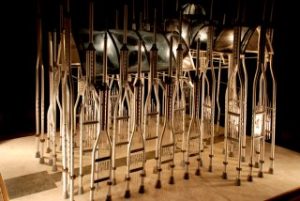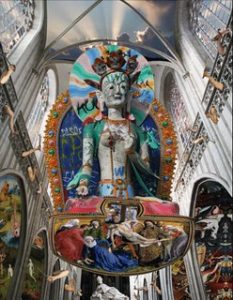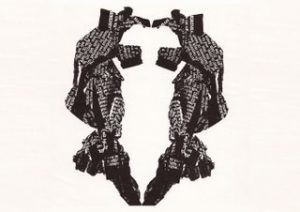The Klines: My Dinner with Yahweh at La Jolla’s JCC
Bodhisattvas, cathedrals, mandalas, and Michelangelo are all on display at the Lawrence Family Jewish Community Center in La Jolla—potentially irreverent and provocative but definitely something to see!
Now on exhibit in the center’s Gotthelf Gallery is Seeing is Believing: A Reinvention of Articles of Faith that was curated by the diabolically clever artist husband and wife team Debby and Larry Kline. Spending two-years curating the exhibition, it is a mix of artists and artworks that explore various aspects of religion: from its capitalist complications and implications to its dogmatic altruisms and idiosyncrasies. The exhibition includes artworks by Michelangelo Buonarroti, brothers Jamex and Einar De La Torre, Dave Ghilarducci, Paula Levine, and Cheryl Nickel.

Cheryl Nickel.
“Gothic Cathedral,” 2010.
Aluminum crutches, test tubes, x-rays; 82″ x 84.5″ x 102.5″. Photo credit (C) 2015 by Robert Leathers. Image courtesy of the artist.
The curators state the exhibition “features artists who contemplate how faith meshes with contemporary life, the role of ritual and symbolism, and the metamorphosis of traditional symbols as they become immersed into popular culture.” The tidy exhibition succeeds in doing so but also delves deeper into the idea of kitsch within religion as well as its aesthetic gaudiness. The exact choice of exhibition venue also adds much to the many layers of dialogue and meaning created by the exhibition as a whole.
A grand example sitting center-stage on a large podium in the Jewish community center’s small Gotthelf Gallery is artist Cheryl Nickel’s “Gothic Cathedral,” 2010. The nearly seven-foot tall by nine-foot long Latin cross shaped basilic structure even features flying buttresses. It is assembled from unusual materials: discarded aluminum crutches that have been bolted together to create the Gothic wonder. Nickel’s genius in choosing this particular material to build her elaborate structure is the specific exploitation of the innate wishbone-shaped design of the metal crutches at the merging bottom apex of the two tubes that hold the underarm support. When turned up-side down, and the underarm supports removed, they recreate the distinctive pointed lancet arches found in high Gothic architecture.
The cathedral also employs old science laboratory glass tubing that hark to stained glass windows, and the roof is sheathed with old x-ray films depicting various bones and internal organs. The x-rays of the rib bones reinforce the idea of ribbed vaulting, which is also prominent in gothic architecture. The other x-rays refer to a body: the body of a mortal parishioner, the body of the congregation, as well as to the body of Christ. Ergo, the entire artwork superbly reenacts the idea of Christian architecture functioning as a simile to all aspects of Christian religion: parts are parts of a whole.
Several other ideas emerge when placed within the Gotthelf Gallery itself. One being a conversation of Old Testament Judaism as being parent to New Testament Christianity and another is the seeming contradiction between Judaism versus Christianity. Also in a historical analysis of art and architecture, a very subtle but important conversation occurs: the pointed lancet arch in Christian architecture references the concept of brit milah (covenant of circumcision). In the accepted narrative of Jesus of Nazareth’s life, the knife used to perform the future Christ’s circumcision on the customary eighth day of life was a lance, thus the decorative motif of the lancet used as arches and windows in Christian architecture specifically refers Abraham’s Covenant with God. In placing Nickel’s “Gothic Cathedral” within the Jewish community center’s Gotthelf Gallery, the Klines have created an even broader dialogue between Jewish ritual and Christian meaning.

Jamex and Einar De la Torre.
“Flemish Tara,” 2013.
Lenticular print; 1 x 1.3 m. Image (C) 2013 by the De La Torre Brothers. Image courtesy of the Artists.
Making what might seem as complete U-turn from serious discourse to a nightmare of outrageous kitsch are artworks by Jamex and Einar De La Torre. Outlandish and gaudy, the De La Torre brothers have juxtaposed imagery from various religions and artworks to create baroque, fantastic three-dimensional illusions printed on lenticular lens plastic, which is commonly found on tacky winking postcards or found in more sophisticated forms of high-tech advertising displays.
The De La Torre brothers’ artwork titled “Flemish Tara” [click hyperlink to see it moving] (2013) is a gaudy feast for the eyes. The artwork features a central floating Bodhisattva figure known as Tara floating on a pillow in the nave of Antwerp Cathedral. Tara, sometimes referred to as the Mother of all Buddhas, has two personas: the Green Tara representing night and the White Tara representing day. In the image, it is a White Tara floating on the pillow in the whitewashed interior of the cathedral, which has been stripped of its roof and opened to the sky. The floating female manifestation is not a figure of divine purity but is instead a mass-produced broken plaster representation defaced with graffiti. The pillow on which Tara floats has been embellished with a computer generated wrap of the famous painting “Descent from the Cross,” (ca. 1435) by Flemish painter Rogier van der Weyden, which was one of the first images in art history where Mary is introduced into the visual narrative of the Jesus’s body being brought down from the cross. In the painting, the Virgin is swooning and this detail would become a dominant inspiration in future depictions of deposition scenes for more than two-hundred years. Also, images from Netherlandish painter Hieronymus Bosch’s framed triptych “The Garden of Earthly Delights” (ca. 1504) fill the cathedral’s surrounding aisles and affixed to the surface of the overlarge postcard-like image are cast resin likenesses of Beethoven, Dickens, Shakespeare, Wagner, and Verdi.
Perhaps, by placing a depiction of White Tara within the context of a the whitewashed interior of the cathedral, the De La Torre Brothers are postulating that Mary, Queen of Heaven, is universal female archetype of religion. Another possible reading could be that by replacing Mary with a poor quality plaster cast of White Tara, they are acknowledging mass-produced devotional imagery used by common people that are actually devaluing schlock: think of neon Virgin Marys, mass-produced super-saturated hue posters of the Virgin as well as cheap plaster casts of the Virgin. Various religions that have embraced iconophilism have a long tradition of tacky and kitsch relics. In the days of yore: think of the fake relics that adorned pilgrimage churches to lure the faithful. Today, one can think of plastic crucifixes, plates with Jesus imagery—even shiny plastic gold hue Buddhas. All have a place in the affectation of religion, which common people daily display to either remind themselves of their religious virtues or to outwardly advertise their beliefs.
One difficulty of the “Flemish Tara” is that there are too many possible readings of the overall image, but by creating their artwork out of lenticular plastic, the De La Torre brothers are recreating a grand theatrical spectacle: a large tacky, kitsch postcard of an all-you-can-eat buffet of unrelated individual meanings as though multiple unrelated themes were drawn from a hat and randomly composited together via computer software. Though with the resin casts of over-the-top composers Verdi and Wagner watching over the postcard kitsch mess of all too many clashing meanings, perhaps it is the audacious, corrosively visual spectacle overkilling the viewer’s gaze with overt bedazzlement that makes the work a success.
Another pair of kitsch artworks in the exhibition are replica heads of Jesus and Mary from Michelangelo’s famous “Pietà” (1498–1499) sculpture. One-hundred fully realized 1:1 scale replicas of the entire Pietà and each priced at $250,000 have been recently created by Arte Divine, who is the exclusive sculpture licensee of the Vatican Observatory Foundation. They are intended to be purchased as gifts for churches and schools. They are billed as posthumous, precise cast editions from molds made directly from Michelangelo’s famed sculpture that have been cast in epoxy resin mixed with authentic carrara marble dust from the exact quarry where Michelangelo obtained his original marble block for the famed statue.
The two heads were created as benefactor gifts to donors who purchase a replica Pietà and then donate it. The heads are on loan from Alexander Salazar Fine Art Gallery (San Diego), but the quality of two heads are not great casts due to several finishing errors nor do they have any visual quality has any similarity to actual marble. They appear to be just faulty plaster factory-seconds painted with white semi-gloss paint, which embody more examples of albeit very expensive mass-produced religious themed junk. Yes, Michelangelo’s Pietà has finally succumbed to a low level of kitsch continuously heaped upon his other masterwork the “David”(1501–04). Where’s a feather boa and lipstick when you need it?

Paula Levine.
Image from from series “Bible Rorschachs,” 1995-98. Series of ten photographs; each 10″ x 8″. Image credit (C) 1998 by Paula Levine. Image courtesy of the artist.
Taking a stab at both the Old and New Testaments, artist Paula Levine has created several images titled “Bible Rorschachs,” 1995-98. Pages from The Bible have been ripped-up and reconstituted then photographically mirrored into images resembling the inkblots used in psychological testing. Traces of biblical passes can been seen. The artwork alludes to religion as something that is perpetually and subjectively interpreted—like a Rorschach test.
The inkblot-like images have some conceptual implications, but as executed, the images appear more like mirrored images of random spat-out pieces of licorice flavored chewing gum with random words imprinted on them. They also appear more random than the precisely designed Rorschach ink-blots. This imparts an air of casualness that contradicts controlled psychological testing. The artist has attempted to address this by trying to link her work with the 19th-century parlor game called “Blotto,” where participants created random inkblots and played a game of free association. There are even blank forms for gallery viewers to record their casual impressions as they observe each of her images, but this steers far from acute science. Due to implications of imprecision, a dissatisfying effect occurs when seriously contemplating the overall series of ten images making them seem either confused or unintentionally contradictory, which robs the artwork of its potential power of critique.
Also included in the exhibition is a coin operated mechanism, titled “Change for Salvation” by Dave Ghilarducci. As one places coins into the device, words of wisdom emerge. As a work, its extraordinary engineering complexity acts as camouflage, thus a viewer focuses more on the complex gimmickry of the device that uses slight-of-hand to discourage a critique of capitalist religious consumption. It therefore perfectly functions like a charlatan religious organization.
As an exhibition, Seeing is Believing: A Reinvention of Articles of Faith is actually successful due to the juxtaposition of the artworks as the overall theme is actually the failure of spiritual rituals and the ridiculous articles used as surrogates for faith. While the individual artworks may seem weak in certain terms, united they achieve a successful discussion and critique of religion. Religious customs should be deemed as suspicious and therefore challenged. The Klines’ curatorial effort also succeeds because of its all-inclusiveness of religions that allow iconic imagery to devalue the actual spiritual experience. As the curators intended to make a meal of comparisons that both prod and provoke, a viewer cannot come away without remembering the taste of extravagance of the objects included in the exhibition, which proves that consuming both the lurid and the ludicrous can achieve a full diet of thoughtful, serious debate.
(Due to security concerns, prior arrangements to visit the exhibit must be made in advance by calling the San Diego Center for Jewish Culture, Lawrence Family Jewish Community Center, JACOBS FAMILY CAMPUS at 858-362-1114 or by emailing the center at [email protected]).
Seeing is Believing: A Reinvention of Articles of Faith on view 11 March through 4 June 2015 in the Gotthelf Gallery at the Lawrence Family Jewish Community Center, 4126 Executive Drive, La Jolla, CA 92037 | 858.457.3030 (front desk) | 858.362.1348 (box office)
www.sdcjc.org

Kraig Cavanaugh lectures about art history—specializing in Modern & Contemporary Art—as well as being an instructor of color theory, design, and studio art. He has curated numerous art exhibitions, authored exhibition catalogues, and written art reviews for several other print and online journals including “Artweek” (USA) and “Selvedge” (UK) magazines. Cavanaugh is also an invited member of the Association Internationale des Critiques d’Art (United States division), which is an NGO in official relations with UNESCO.
